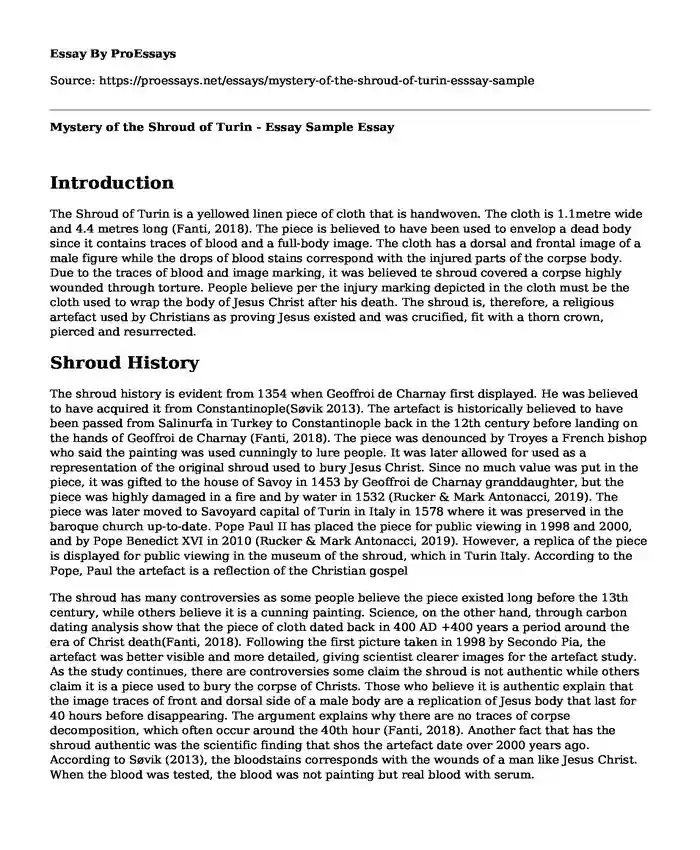Introduction
The Shroud of Turin is a yellowed linen piece of cloth that is handwoven. The cloth is 1.1metre wide and 4.4 metres long (Fanti, 2018). The piece is believed to have been used to envelop a dead body since it contains traces of blood and a full-body image. The cloth has a dorsal and frontal image of a male figure while the drops of blood stains correspond with the injured parts of the corpse body. Due to the traces of blood and image marking, it was believed te shroud covered a corpse highly wounded through torture. People believe per the injury marking depicted in the cloth must be the cloth used to wrap the body of Jesus Christ after his death. The shroud is, therefore, a religious artefact used by Christians as proving Jesus existed and was crucified, fit with a thorn crown, pierced and resurrected.
Shroud History
The shroud history is evident from 1354 when Geoffroi de Charnay first displayed. He was believed to have acquired it from Constantinople(Søvik 2013). The artefact is historically believed to have been passed from Salinurfa in Turkey to Constantinople back in the 12th century before landing on the hands of Geoffroi de Charnay (Fanti, 2018). The piece was denounced by Troyes a French bishop who said the painting was used cunningly to lure people. It was later allowed for used as a representation of the original shroud used to bury Jesus Christ. Since no much value was put in the piece, it was gifted to the house of Savoy in 1453 by Geoffroi de Charnay granddaughter, but the piece was highly damaged in a fire and by water in 1532 (Rucker & Mark Antonacci, 2019). The piece was later moved to Savoyard capital of Turin in Italy in 1578 where it was preserved in the baroque church up-to-date. Pope Paul II has placed the piece for public viewing in 1998 and 2000, and by Pope Benedict XVI in 2010 (Rucker & Mark Antonacci, 2019). However, a replica of the piece is displayed for public viewing in the museum of the shroud, which in Turin Italy. According to the Pope, Paul the artefact is a reflection of the Christian gospel
The shroud has many controversies as some people believe the piece existed long before the 13th century, while others believe it is a cunning painting. Science, on the other hand, through carbon dating analysis show that the piece of cloth dated back in 400 AD +400 years a period around the era of Christ death(Fanti, 2018). Following the first picture taken in 1998 by Secondo Pia, the artefact was better visible and more detailed, giving scientist clearer images for the artefact study. As the study continues, there are controversies some claim the shroud is not authentic while others claim it is a piece used to bury the corpse of Christs. Those who believe it is authentic explain that the image traces of front and dorsal side of a male body are a replication of Jesus body that last for 40 hours before disappearing. The argument explains why there are no traces of corpse decomposition, which often occur around the 40th hour (Fanti, 2018). Another fact that has the shroud authentic was the scientific finding that shos the artefact date over 2000 years ago. According to Søvik (2013), the bloodstains corresponds with the wounds of a man like Jesus Christ. When the blood was tested, the blood was not painting but real blood with serum.
Bloodstain in the Shroud
In accordance with Søvik (2013), those who oppose arguing the corpse was not that of Christ, argued that the corpse could be any other persons rather than Christ since; during Christ, era people were often crucified. In addition, the fact that science-dating methods show the cloth dated 2000 years back, it is impossible to place the body to be that of Christ wrapped in the cloth (Søvik 2013). In addition, based on the cloth fabric and art used in the weaving of the piece is liked to the Mandylion. The fabric was an oven with flax harvested between 1263-1390 AD facts that caused people to oppose the cloth to have been used on the corpse of Christ. When the dust was tested, it showed to be from the Indian origin; however, it is explained the cloth might have been from India and traded to a person in Jerusalem.
Conclusion
After examining all the fact, I believe thesharaud is not a represention of the body is not of christ despite having all possible characteristic. I, therefore, say the artifact is a hoax. The piece is aimed at provoking religious intelligence, and it is not until scientist provides reasonable proof of the piece being that of Christ that it can be qualified as real christ history.
References
Rucker, R. A., & Mark Antonacci, J. D. (2019). Status of Research on the Shroud of Turin. http://www.shroudresearch.net/hproxy.php/Status-of-Research-on-the-Shroud-of-Turin.pdf
Fanti, G. (2018). Why Is the Turin Shroud Authentic? Glob. J. Arch. Anthropol, 7. DOI: 10.19080/GJAA.2018.07.555707
Søvik, A. O. (2013). The Shroud of Turin - A Critical Assessment Teologisk Tidsskrift (Journal of Theology), 3: 266-294. https://www.academia.edu/7236952/The_Shroud_of_Turin_A_Critical_Assessment
Yirka, B. (2018, July 24). New study suggests Shroud of Turin a fake, supporting study retracted. Retrieved August 28, 2020, from
https://phys.org/news/2018-07-shroud-turin-fake-retracted.html.
Cite this page
Mystery of the Shroud of Turin - Essay Sample. (2023, Nov 16). Retrieved from https://proessays.net/essays/mystery-of-the-shroud-of-turin-esssay-sample
If you are the original author of this essay and no longer wish to have it published on the ProEssays website, please click below to request its removal:
- Theology: Discussion on Theology of Miracles
- Paper Example on Tolerance and Coercion in Islam
- Research Paper on Muslim Culture and Healthcare
- Spinoza's Philosophy on Problems of Desire and Freedom
- Essay Example on Traditions of the Dead Still Influence the Living: Marx's Views
- Islam Religion: Beliefs, History, & Impact on Christianity - Annotated Bibliography
- Essay Example on Hebrews Letter: Reaffirming Faith in the Face of Persecution







